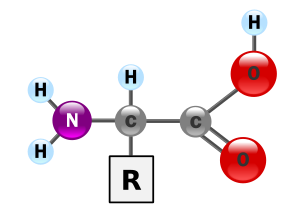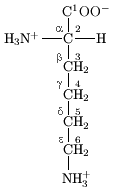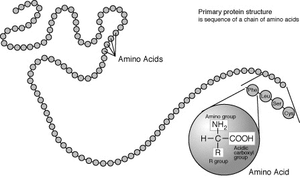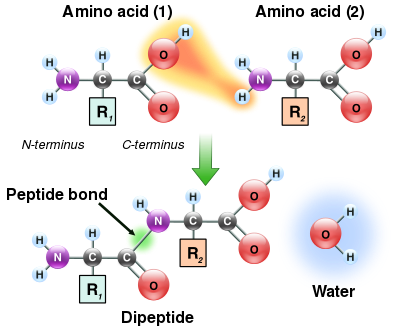In chemistry, an amino acid is a molecule containing both amine and carboxyl functional groups. These molecules are particularly important in biochemistry, where this term refers to alpha-amino acids with the general formula H2NCHRCOOH, where R is an organic substituent. In the alpha amino acids, the amino and carboxylate groups are attached to the same carbon, which is called the α–carbon. The various alpha amino acids differ in which side chain (R group) is attached to their alpha carbon. They can vary in size from just a hydrogen atom in glycine through a methyl group in alanine to a large heterocyclic group in tryptophan.
Amino acids are critical to life, and have a variety of roles in metabolism. One particularly important function is as the building blocks of proteins, which are linear chains of amino acids. Amino acids are also important in many other biological molecules, such as forming parts of coenzymes, as in S-adenosylmethionine, or as precursors for the biosynthesis of molecules such as heme. Due to this central role in biochemistry, amino acids are very important in nutrition.
The amino acids are commonly used in food technology and industry. For example, monosodium glutamate is a common flavor enhancer that gives foods the taste called umami. Beyond the amino acids that are found in all forms of life, amino acids are also used in industry, with the production of biodegradable plastics, drugs and chiral catalysts being particularly important applications.
Overview
Alpha-amino acids are the building blocks of proteins. Amino acids combine in a condensation reaction, that is, through dehydration synthesis, that releases water and the new "amino acid residue" that is held together by a peptide bond. Proteins are defined by their unique sequence of amino acid residues; this sequence is the primary structure of the protein. Just as the letters of the alphabet can be combined to form an almost endless variety of words, amino acids can be linked in varying sequences to form a vast variety of proteins.
Twenty standard amino acids are used by cells in protein biosynthesis, and these are specified by the general genetic code. These 20 amino acids are biosynthesized from other molecules, but organisms differ in which ones they can synthesize and which ones must be provided in their diet. The ones that cannot be synthesized by an organism are called essential amino acids.
General structure
In the structure shown at the top of the page, R represents a side chain specific to each amino acid. The carbon atom next to the carbonyl group is called the α–carbon and amino acids with a side chain bonded to this carbon are referred to as alpha amino acids. These are the most common form found in nature. In the alpha amino acids, the α–carbon is a chiral carbon atom (with the exception of glycine). In amino acids that have a carbon chain attached to the α–carbon, as in lysine on the right, the carbons are labeled in order as α, β, γ, δ, and so on. In some amino acids, the amine group is attached to the β or γ-carbon, and these are therefore referred to as beta or gamma amino acids.
Amino acids are usually classified by the properties of their side chain into four groups. The side chain can make them behave like a weak acid, a weak base, a hydrophile if they are polar, and hydrophobe if they are nonpolar. The chemical structures of the 20 standard amino acids, along with their chemical properties, are catalogued in the list of standard amino acids.
The phrase "branched-chain amino acids" or BCAA is sometimes used to refer to the amino acids having aliphatic side chains that are non-linear; these are leucine, isoleucine, and valine. Proline is the only proteinogenic amino acid whose side group links to the α-amino group and, thus, is also the only proteinogenic amino acid containing a secondary amine at this position. Proline has sometimes been termed an imino acid, but this is not correct in the current nomenclature.
Isomerism
Of the standard α-amino acids, all but glycine can exist in either of two optical isomers. While L-amino acids represent the vast majority of amino acids found in proteins, D-amino acids are found in some proteins produced by exotic sea-dwelling organisms, such as cone snails. They are also abundant components of the peptidoglycan cell walls of bacteria. and D-serine may act as a neurotransmitter in the brain. The L and D convention for amino acid configuration refers not to the optical activity of the amino acid itself, but rather to the optical activity of the isomer of glyceraldehyde from which that amino acid can theoretically be synthesized (D-glyceraldehyde is dextrorotary; L-glyceraldehyde is levorotary). Alternatively, the (S) and (R) designators are used to indicate the absolute stereochemistry. Almost all of the amino acids in proteins are (S) at the α carbon, with cysteine being (R) and glycine nonchiral. Cysteine is unusual since it has a sulfur atom at the first position in its side-chain, which has a larger atomic mass than the groups attached to the α-carbon in the other standard amino acids, thus the (R) instead of (S).
Zwitterions
As amino acids have both an amine and a carboxylic acid functional group and are therefore both acid and base at the same time. At a certain compound-specific pH known as the isoelectric point, the number of protonated ammonium groups with a positive charge and deprotonated carboxylate groups with a negative charge are equal, resulting in a net neutral charge These ions are known as a zwitterion, which comes from the German word Zwitter meaning "hybrid". Amino acids are zwitterions in solid phase and in polar solutions such as water and depending on the pH, but not in the gas phase. Zwitterions have minimal solubility at their isolectric point and amino acids are often isolated by precipitation from water after adjusting the pH to their isolectric point.
Occurrence and functions in biochemistry
Standard amino acids
Amino acids are the basic structural building units of proteins. They form short polymer chains called peptides or longer chains called either polypeptides or proteins. These polymers are linear and unbranched. The process of making proteins is called translation and involves the step-by-step addition of amino acids to a growing protein chain by a ribozyme that is called a ribosome. The order in which the amino acids are added is read through the genetic code from an mRNA template, which is a RNA copy of one of the organism's genes. Twenty amino acids are encoded by the standard genetic code and are called proteinogenic or standard amino acids.
Non-standard amino acids
Aside from the twenty standard amino acids, there are a vast number of "non-standard" amino acids. Two of these can be specified by the genetic code, but are rather rare in proteins. Selenocysteine is incorporated into some proteins at a UGA codon, which is normally a stop codon. Pyrrolysine is used by some methanogenic archaea in enzymes that they use to produce methane. It is coded for with the codon UAG. Other non-standard amino acids found in proteins are formed by post-translational modification, which is modification after translation in protein synthesis. These modifications are often essential for the function or regulation of a protein; for example, the carboxylation of glutamate allows for better binding of calcium cations, and the hydroxylation of proline is critical for maintaining connective tissues. Such modifications can also determine the localization of the protein, e.g., the addition of long hydrophobic groups can cause a protein to bind to a phospholipid membrane.
Examples of nonstandard amino acids that are not found in proteins include lanthionine, 2-aminoisobutyric acid, dehydroalanine and the neurotransmitter gamma-aminobutyric acid. Nonstandard amino acids often occur as intermediates in the metabolic pathways for standard amino acids — for example ornithine and citrulline occur in the urea cycle, part of amino acid catabolism (see below). A rare exception to the dominance of α-amino acids in biology is the β-amino acid beta alanine (3-aminopropanoic acid), which is used in plants and microorganisms in the synthesis of pantothenic acid (vitamin B5), a component of coenzyme A.
In human nutrition
When taken up into the body in the diet, the 20 standard amino acids are either used to synthesize proteins and other biomolecules or oxidized to urea and carbon dioxide as a source of energy. The oxidation pathway starts with the removal of the amino group by a transaminase, the amino group is then fed into the urea cycle. The other product of transamidation is a keto acid that enters the citric acid cycle. Glucogenic amino acids can also be converted into glucose, through gluconeogenesis.
Of the 20 standard amino acids, 8 are called essential amino acids because the human body cannot synthesize them from other compounds at the level needed for normal growth, so they must be obtained from food. However, the situation is quite complicated since cysteine, taurine, tyrosine, histidine and arginine are semiessential amino acids in children, because the metabolic pathways that synthesize these amino acids are not fully developed. The amounts required also depend on the age and health of the individual, so it is hard to make general statements about the dietary requirement for some amino acids.
| Essential | Nonessential |
|---|---|
| Isoleucine | Alanine |
| Leucine | Asparagine |
| Lysine | Aspartate |
| Methionine | Cysteine* |
| Phenylalanine | Glutamate |
| Threonine | Glutamine* |
| Tryptophan | Glycine* |
| Valine | Proline* |
| Serine* | |
| Tyrosine* | |
| Arginine* | |
| Histidine* |
(*) Essential only in certain cases.
Several common mnemonics have evolved for remembering the ten amino acids often described as essential. PVT TIM HALL ("Private Tim Hall") uses the first letter of each of these amino acids. Another mnemonic that frequently occurs in student practice materials beneath "AH TV TILL Past Midnight", is "These ten valuable amino acids have long preserved life in man".
Non-protein functions
In humans, non-protein amino acids also have important roles as metabolic intermediates, such as in the biosynthesis of the neurotransmitter gamma-aminobutyric acid. Many amino acids are used to synthesize other molecules, for example:
- Tryptophan is a precursor of the neurotransmitter serotonin.
- Glycine is a precursor of porphyrins such as heme.
- Arginine is a precursor of nitric oxide.
- Ornithine and S-adenosylmethionine are precursors of polyamines.
- Aspartate, glycine and glutamine are precursors of nucleotides.
However, not all of the functions of other abundant non-standard amino acids are known, for example taurine is a major amino acid in muscle and brain tissues, but although many functions have been proposed, its precise role in the body has not been determined.
Some non-standard amino acids are used as defenses against herbivores in plants. For example canavanine is an analogue of arginine that is found in many legumes, and in particularly large amounts in Canavalia gladiata (sword bean). This amino acid protects the plants from predators such as insects and can cause illness in people if some types of legumes are eaten without processing. The non-protein amino acid mimosine is found in other species of legume, particularly Leucaena leucocephala. This compound is an analogue of tyrosine and can poison animals that graze on these plants.
Uses in technology
Amino acids are used for a variety of applications in industry. The major use for these compounds is as an additive to animal feed, since many of the bulk components of these products, such as soybeans, either have low levels or lack some of the essential amino acids: lysine, methionine, threonine, and tryptophan are most important in the production of these feeds. The food industry is also a major consumer of amino acids, particularly glutamic acid, which is used as a flavor enhancer, and Aspartame (aspartyl-phenylalanine-1-methyl ester) as a low-calorie artificial sweetener. The remaining production of amino acids is used in the synthesis of drugs and cosmetics.
| Amino acid derivative | Pharmaceutical application |
|---|---|
| 5-HTP (5-hydroxytryptophan) | Experimental treatment for depression. |
| L-DOPA (L-dihydroxyphenylalanine) | Treatment for Parkinsonism. |
| Eflornithine | Drug that inhibits ornithine decarboxylase and is used in the treatment of sleeping sickness. |
Chiral catalysts
In the chemical industry, amino acids are important as low-cost feedstocks in chiral synthesis. Here, these compounds are used in chiral pool synthesis as enantiomerically-pure building blocks that can be assembled into the desired chiral product. Alternatively, amino acids can be used to create chiral catalysts, such as by incorporating a ruthenium atom into proline to produce a catalyst that can carry out asymmetric hydrogenation reactions.
Biodegradable plastics
Amino acids are under development as components of a range of biodegradable polymers. These materials have applications as environmentally-friendly packaging and in medicine in drug delivery and the construction of prosthetic implants. These polymers include polypeptides, polyamides, polyesters, polysulfides and polyurethanes with amino acids either forming part of their main chains, or bonded as side chains to modify the physical properties and reactivities of the polymers. An interesting example of such materials is polyaspartate, a water-soluble biodegradable polymer that may have applications in disposable diapers and agriculture. Due to its solubility and ability to chelate metal ions, polyaspartate is also being used as a biodegradeable anti-scaling agent and a corrosion inhibitor. In addition, the aromatic amino acid tyrosine is being developed as a possible replacement for toxic phenols such as bisphenol A in the manufacture of polycarbonates.
Reactions
As amino acids have both a primary amine group and a primary carboxyl group, these chemicals can undergo most of the reactions associated with these functional groups. These include nucleophilic addition, amide bond formation and imine formation for the amine group and esterification, amide bond formation and decarboxylation for the carboxylic acid group. The multiple side chains of amino acids can also undergo chemical reactions. The types of these reactions are determined by the groups on these side chains and are discussed in the articles dealing with each specific type of amino acid.
Chemical synthesis
Several methods exist to synthesize amino acids. One of the oldest uses the Hell-Volhard-Zelinsky halogenation to introduce a bromine atom on the α-carbon. Nucleophilic substitution of the bromine with ammonia then yields the amino acid. Alternatively, the Strecker amino acid synthesis involves the treatment of an aldehyde with potassium cyanide and ammonia, this produces an α-amino nitrile as an intermediate. Hydrolysis of the nitrile in acid then yields a α-amino acid. Using ammonia or ammonium salts in this reaction gives unsubstituted amino acids, while substituting primary and secondary amines will yield substituted amino acids. Likewise, using ketones, instead of aldehydes, gives α,α-disubstituted amino acids. The classical synthesis gives racemic mixtures of α-amino acids as products, but several alternative procedures using asymmetric auxiliaries or asymmetric catalysts have been developed.
Peptide bond formation
As both the amine and carboxylic acid groups of amino acids can react to form amide bonds, one amino acid molecule can react with another and become joined through an amide linkage. This polymerization of amino acids is what creates proteins. This condensation reaction yields the newly formed peptide bond and a molecule of water. In cells, this reaction does not occur directly; instead the amino acid is first activated by attachment to a transfer RNA molecule through an ester bond. This aminoacyl-tRNA is produced in an ATP-dependent reaction carried out by an aminoacyl tRNA synthetase. This aminoacyl-tRNA is then a substrate for the ribosome, which catalyzes the attack of the amino group of the elongating protein chain on the ester bond. As a result of this mechanism, all proteins made by ribosomes are synthesized starting at their N-terminus and moving towards their C-terminus.
However, not all peptide bonds are formed in this way. In a few cases, peptides are synthesized by specific enzymes. For example, the tripeptide glutathione is an essential part of the defenses of cells against oxidative stress. This peptide is synthesized in two steps from free amino acids. In the first step gamma-glutamylcysteine synthetase condenses cysteine and glutamic acid through a peptide bond formed between the side-chain carboxyl of the glutamate (the gamma carbon of this side chain) and the amino group of the cysteine. This dipeptide is then condensed with glycine by glutathione synthetase to form glutathione.
In chemistry, peptides are synthesized by a variety of reactions. One of the most used in solid-phase peptide synthesis, which uses the aromatic oxime derivatives of amino acids as activated units. These are added in sequence onto the growing peptide chain, which is attached to a solid resin support. The ability to easily synthesize vast numbers of different peptides by varying the types and order of amino acids (using combinatorial chemistry) has made peptide synthesis particularly important in creating libraries of peptides for use in drug discovery through high-throughput screening.
Biosynthesis and catabolism
In plants, nitrogen is first assimilated into organic compounds in the form of glutamate, formed from alpha-ketoglutarate and ammonia in the mitochondrion. In order to form other amino acids, the plant uses transaminases to move the amino group to another alpha-keto carboxylic acid. For example, aspartate aminotransferase converts glutamate and oxaloacetate to alpha-ketoglutarate and aspartate. Other organisms use transaminases for amino acid synthesis too. Transaminases are also involved in breaking down amino acids. Degrading an amino acid often involves moving its amino group to alpha-ketoglutarate, forming glutamate. In many vertebrates, the amino group is then removed through the urea cycle and is excreted in the form of urea. However, amino acid degradation can produce uric acid or ammonia instead. For example, serine dehydratase converts serine to pyruvate and ammonia.
Nonstandard amino acids are usually formed through modifications to standard amino acids. For example, homocysteine is formed through the transsulfuration pathway or by the demethylation of methionine via the intermediate metabolite S-adenosyl methionine, while hydroxyproline is made by a posttranslational modification of proline.
Microorganisms and plants can synthesize many uncommon amino acids. For example, some microbes make 2-aminoisobutyric acid and lanthionine, which is a sulfide-bridged alanine dimer. Both these amino acids are found in peptidic lantibiotics such as alamethicin. While in plants, 1-aminocyclopropane-1-carboxylic acid is a small disubstituted cyclic amino acid that is a key intermediate in the production of the plant hormone ethylene.
Hydrophilic and hydrophobic amino acids
Depending on the polarity of the side chain, amino acids vary in their hydrophilic or hydrophobic character. These properties are important in protein structure and protein-protein interactions. The importance of the physical properties of the side chains comes from the influence this has on the amino acid residues' interactions with other structures, both within a single protein and between proteins. The distribution of hydrophilic and hydrophobic amino acids determines the tertiary structure of the protein, and their physical location on the outside structure of the proteins influences their quaternary structure.
For example, soluble proteins have surfaces rich with polar amino acids like serine and threonine, while integral membrane proteins tend to have outer ring of hydrophobic amino acids that anchors them into the lipid bilayer, and proteins anchored to the membrane have a hydrophobic end that locks into the membrane. Similarly, proteins that have to bind to positively-charged molecules have surfaces rich with negatively charged amino acids like glutamate and aspartate, while proteins binding to negatively-charged molecules have surfaces rich with positively charged chains like lysine and arginine. Recently a new scale of hydrophobicity based on the free energy of hydrophobic association has been proposed.
Hydrophilic and hydrophobic interactions of the proteins do not have to rely only on the sidechains of amino acids themselves. By various posttranslational modifications other chains can be attached to the proteins, forming hydrophobic lipoproteins,
Table of standard amino acid abbreviations and side chain properties
In addition to the specific amino acid codes, placeholders were used historically in cases where chemical or crystallographic analysis of a peptide or protein could not conclusively determine the identity of a residue.
| Ambiguous Amino Acids | 3-Letter | 1-Letter |
|---|---|---|
| Asparagine or aspartic acid | Asx | B |
| Glutamine or glutamic acid | Glx | Z |
| Leucine or Isoleucine | Xle | J |
| Unspecified or unknown amino acid | Xaa | X |
Unk is sometimes used instead of Xaa, but is less standard.




















No comments:
Post a Comment